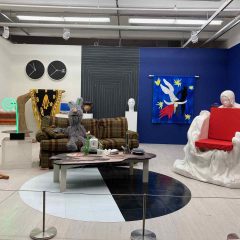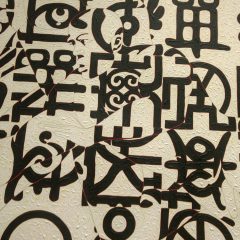Yinka Shonibare MBE (Prestel Verlag, Munich, 2008) ISBN 978-3-7913-4123-1
Yinka Shonibare is a contemporary of the Young British Artists and while he exhibited with them, he has never been considered one of the group. Unlike them, he creates work of unapologetic beauty. Shonibare uses beauty as a hook; it draws audiences for his manipulated, historicist figures and tableaux which play havoc with received notions about post-Enlightenment Europe and reveal the impossibility of separating cultural history from economic history. His work has been increasingly visible in the U.S., especially since the large survey organized by the Museum of Contemporary Art, Sydney that was seen at the National Museum of African Art in D.C. and at the Brooklyn Museum in 2008-10. This volume was produced as the exhibition’s catalog and functions as an ideal monograph on its own; it presents an excellent survey of the artist’s work in painting, sculpture, installations, photography and film, and essays that broadly address his background and work, as well as the usual back matter. It is handsomely illustrated and hence vividly polychrome, because of Shonibare’s characteristic use of the Dutch, wax-printed cottons that were produced for trade in West Africa.
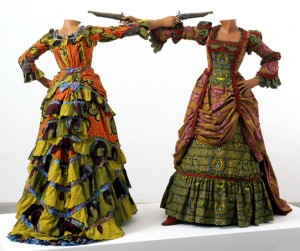
Between the essay by Robert Hobbs and the conversation between the artist and Anthony Downey, the volume gives a nuanced reading of the British-educated, Nigerian artist’s background, education, current situation in London, and the breadth of his thinking. Shonibare was raised partly in Nigeria and partly in the U.K., and has had to negotiate both cultures from a perspective slightly off-center; he is too much of a cosmopolitan to fit easily into either. He is well-read and highly articulate in explicating the many layers of meaning that his work embodies.
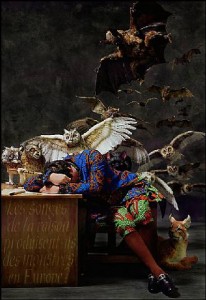
Hobbs, in his essay Yinka Shonibare MBE: the politics of representation, addresses the artist’s background and education and the part they have played in Shonibare’s use of visual signifiers of origins and authenticity. He also examines the history, economics and politics of the trade in Dutch, wax-printed cottons and Shonibare’s sophisticated use of their inherent tensions: products of colonial economic interests, they reflect both a Dutch colonial appropriation of Indonesian technique and a European projection of African taste. The printed fabrics were embraced by their African consumers and have become a common signifier of African aesthetics. Like the cottons, Shonibare is a product of cross-continental origin whose identity, at this point, is a reflection of education and choice rather than a straightforward product of geography.
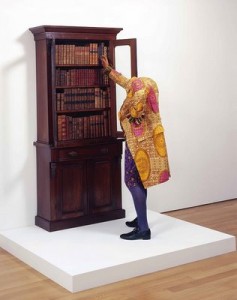
The Global Africa Project (Museum of Art and Design, New York and Prestel Verlag, Munich, 2010) ISBN 978-3-7913-5084-4
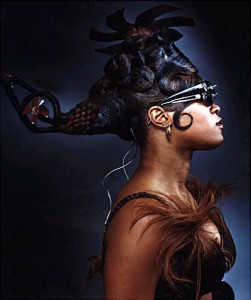
The Global Africa Project is the catalog of an exhibition at the Museum of Arts and Design, New York through May 15, 2010 which gives a panoramic overview of current art and design that reflects an Africanist perspective. While it is pioneering and an eye-opener, everyone understands that a single exhibition cannot cover the entire material culture of a continent in depth, and the catalog makes no attempt to make up for that. It offers multiple viewpoints by the two curators, Lowery Stokes Sims and Leslie King-Hammond, and seven other scholars and writers, each offering a glimpse of some aspect of current work in the decorative and fine arts by Africanist artists and designers; some are Africans, others are Africans living elsewhere or products of the African diaspora, still others are Europeans or Americans who have spent time in Africa and/or were influenced by Africanist aesthetics. Whew!!
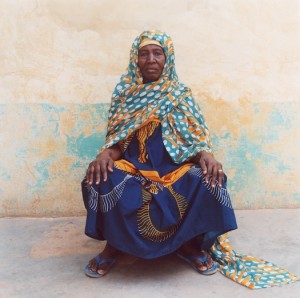
The intent of The Global Africa Project was to broaden the idea of visual culture coming out of Africa, and I suspect it will do that for almost every reader. Some of the work was intended for local consumption, hence unlikely to attract international attention. Other work suffers from under-capitalized production, distribution and marketing. For still others the African designers have been hidden behind the European or American manufacturers for whom they work. One of the strengths of the catalog as a whole is the extent to which it interweaves the economic and social conditions with the aesthetic ones.
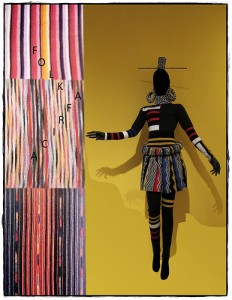
The work overwhelmingly represents an urban Africa, and one that has, itself, absorbed international ideas along with trade and travel. The range of objects illustrated (very handsomely and in full color) includes painting, sculpture, photography, decorative textiles, illustration, graphic design, web design, high fashion and ready to wear clothing, jewelry, hair-styling, ceramics, basketry, objects d’art, furniture, lighting, wallpaper, architecture, a custom-painted car and the decorative recovery of an abandoned urban neighborhood.

The section on the individual artists is ultimately the most interesting; each entry includes information on the artist’s education, exhibitions, bibliography, website information, an artist’s statement and photograph. This creates a very personalized view of the work on exhibit, but more than that, it clearly reflects just how globalized the art and design world has become. The great majority have studied their art at university level, with many having MFAs and many of those from American universities and art schools. Most of the work produced by collectives that employ traditional craft skills were organized by outsiders who have university training.
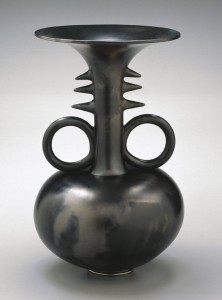
The book includes a bibliography and a list of exhibitions of art from Africa and the African diaspora from 1989-2010. The inclusion of urls for each artist makes the catalog a useful resource for further research on the subject, parts of which have had little attention in print. If the authors don’t convince us that an African influence is as integral to international art and design as it is to much current music, they make a strong case for bringing its sophistication and influence into the spotlight.




